Mobile traffic: its ultra-high, but ultra-passive. What to do with it?
At the beginning of the year, ComScore published interesting statistics. In order to determine the share of mobile traffic, they analyzed the audience of the sites of the largest online stores in America. As a result, the number of visitors from mobile devices exceeded the number of visitors from computers. Moreover, approximately 38% of all users of the Amazon site, 44% of eBay and 59% of Apple access resources ONLY from smartphones.

Of course, in this regard, the runet is still a few steps behind the burzhunet, but the trend is confidently gaining momentum. For example, about a third of all users of Runet, who are now reading this article with you, chat with friends on social networks, sit on dating sites, browse news and watch videos on YouTube from mobile devices. In Russia, the share of mobile traffic accounts for over 20% . Speaking of mobile traffic, we mean the most active audience, which not only reads content, but also makes purchases, pays bills, book tickets and hotels, downloads music, selects goods and services.
')
Next, what mobile traffic is good for, how it differs from desktop traffic, how to multiply and activate it.
What is the difference in mobile traffic?
The share of mobile traffic in different areas can reach up to 75% . Especially actively mobile visitors use social networks. In addition, users spend a lot of time on dating sites, various content resources, online gaming sites. As for e-commerce, mobile visitors prefer to make cheap purchases or look for information that will ultimately help make a purchasing decision. A significant proportion of mobile traffic in such topics as clothing, shoes, electronics, household goods, cosmetics, fitness.
Of course, the behavior of those who use the Internet via a smartphone is different from the behavior of people using stationary equipment. This is explained not only by the features of the devices themselves, but also by what time and under what circumstances the device is most often used.
According to statistics , 48% of mobile sessions begin with “Search”, be it Yandex, Google, YouTube or something else. The trend is especially relevant for such categories as clothing, shoes, household goods, cars. As you know, in April, Google launched the Mobilgeddon algorithm, the purpose of which is to make search engine output as convenient and relevant for mobile users as possible.

Mobile session rarely ends with mobile conversion. The fact is that many use smartphones to search for goods and services, read reviews about them, make a decision about a purchase. The purchase often occurs on a computer or offline. However, do not underestimate the importance of these internet minutes. At a recent webinar , a Google representative said that 91% of all users who are looking for information about products and services via smartphones are eventually converted.
Mobile session, as a rule, is longer than the one that occurs on the desktop. It is inconvenient for users to switch between sites and screens, as they would on a computer. Therefore, if the site and the information placed on it suit the user, it is likely to remain on it.
Much of the mobile minutes accounted for by social networks. According to The Experian , if all the minutes that mobile users spend on the network equate to one hour, then social networks will take about 16 minutes, or one quarter of the total time.
Mobile users rarely share content and even less often write comments to it. According to Moovweb statistics, out of 61 million sessions that were analyzed, only 0.2% received Share . This figure is on average 35% less than the results of sessions on desktops. There are many reasons for this: from the banal desire to save battery power on a mobile phone and inconvenient buttons and commenting forms to a reason lying in the user's tasks plane. Why should he comment on anything on the mobile site if the lively discussion on the issue goes on the social network? Why should he share something with all friends on Facebook , if you can just remember the link to these sneakers (conditionally) or send them a picture of your wife?
Thus, we have an audience that:
- actively uses the mobile Internet, visiting social networks, online stores, sites of non-commercial topics (by the way, if you believe the world statistics , then 60% of users use smartphones as the main device for going online);

- (!) Almost does not put Like and Share and has a very passive behavior on mobile sites;
- is limited in its capabilities by time, as well as by the speed of the Internet and the capabilities of the smartphone (the lack of a convenient keyboard, editor, etc.).
How to activate mobile users?
№1. We bet on the buttons adapted for mobile devices
Such buttons recently proposed UpToLike . In RuNet today it is the only Russian-language plug-in of mobile buttons. In the West, this option is in AddThis .
What are the features of these buttons, and what they are better than usual? First, they are large. Secondly, they are fixed at the bottom of the screen and remain there when scrolling. We also add that the webmaster can set the composition of social networks, and most importantly, two new messenger buttons appeared in the lineup: 4Talk and WhatsApp . The first results of use show that the conversion of clicks on messengers from the total number of unique visitors to the site averages 10% . For mobile phones, where the average conversion rate is 0.2% of the total site audience, this is a huge indicator!
Below are a number of examples demonstrating the effectiveness of the WhatsApp button on various websites. In the presented screenshots, you should pay attention to two aspects: the share of activity in WhatsApp (almost the same indicator with desktop buttons), and the curve of attracting new users. From the graph it is clear that through the links in the messengers, new users actually arrive at the sites (several hundreds per month). This is quite a decent indicator, comparable even with such a method of engaging as content marketing. But in our case, for new visits, you don’t need to do anything at all: it’s enough just to have the WhatsApp button and 4talk in your line.
Case No. 1. Women's project about fashion, beauty, relationships, fitness, work.
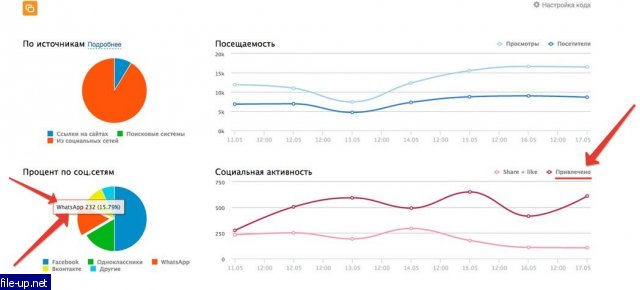
Case No. 2. Information portal of the city in Siberia.
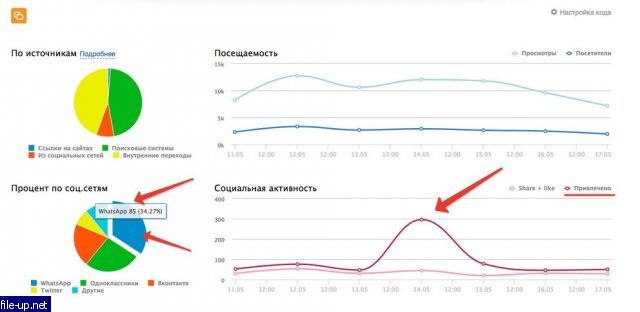
Case No. 3. Foundation for the creation and promotion of social projects in the field of education, culture and other things.
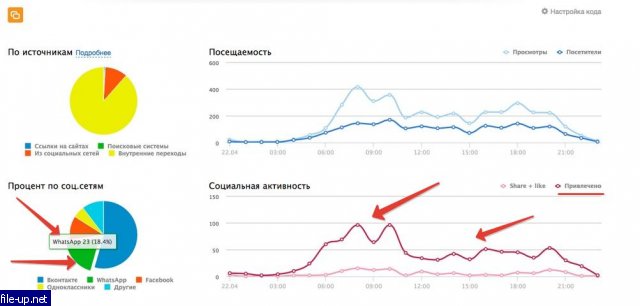
As you can see, WhatsApp accounts for a significant proportion of clicks: the women's project and social projects receive 15.79% and 18.4% of clicks from the messenger, respectively. Information projects, as a rule, generate even more clicks from instant messengers. Thus, the site of the Siberian city receives 34.27% of clicks from WhatsApp .
However, the statistics of involved users is even more important. On average, every third person who clicks on the social button brings new users to the site. At the same time, the statistics on the messenger buttons is usually even more impressive, because in the case of WhatsApp, the links are sent more targeted.
Thanks to the use of buttons adapted for mobile users, as well as the integration of WhatsApp and 4Talk , you can increase the mobile traffic of commercial projects by 6% , and non-commercial projects - by 15% . Moreover, the growth of mobile traffic will be noticeable after 1-3 weeks (depending on the traffic of the resource and the nature of its audience).
№2. Twitter gets more clicks from mobile users than buttons from other social networks.
In the West , smartphone users, not computer users, will make a retweet with a 66% chance.
According to Marketing Charts , Twitter is particularly effective on topics like business and finance. Here, Twitter accounts for 67% of the total Share . The audience is more likely to use Twitter on their way to work, during their lunch break and on their way home. That's when it is preferable to publish updates on blogs, social networks and so on.
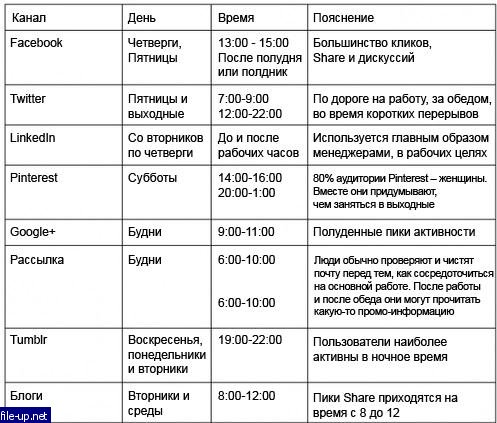
Interesting fact: in general, mobile users most actively share content after 21-00 .
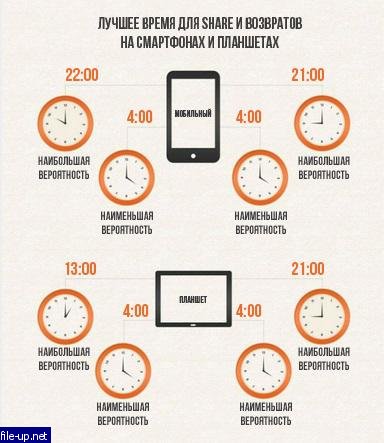
Number 3. Do not forget about the technical subtleties of optimizing resources for mobile users.
- Check how friendly your site is for mobile users. For this you can use, for example, the Google Mobile-Friendly Tool .
- Be sure to use no more than 5 redirects. It is believed that after 5 redirects, search engines do not index mobile pages.
- Accelerate the loading site. 40% of visitors leave the site if it is loaded for more than 3 seconds. Most mobile users are ready to wait no more than 6-10 seconds.
- Do not block JavaScript , CSS and various image files. This will negatively affect the positions in the “Search”, and hence the number of mobile users from Yandex and Google .
- Fix “ 404 Errors” that are issued only to mobile users. There are frequent situations when a page is displayed without problems to desktop users, however, it gives 404 an error to those who are trying to open it from a smartphone.
It is likely that in a few years and we will catch up with Amazon , eBay and Apple in quality and quantity of mobile traffic. In order for this to happen as early as possible, today it is necessary to work on optimizing the site for users of smartphones and tablets, as well as on increasing the share of mobile traffic.

Of course, in this regard, the runet is still a few steps behind the burzhunet, but the trend is confidently gaining momentum. For example, about a third of all users of Runet, who are now reading this article with you, chat with friends on social networks, sit on dating sites, browse news and watch videos on YouTube from mobile devices. In Russia, the share of mobile traffic accounts for over 20% . Speaking of mobile traffic, we mean the most active audience, which not only reads content, but also makes purchases, pays bills, book tickets and hotels, downloads music, selects goods and services.
')
Next, what mobile traffic is good for, how it differs from desktop traffic, how to multiply and activate it.
What is the difference in mobile traffic?
The share of mobile traffic in different areas can reach up to 75% . Especially actively mobile visitors use social networks. In addition, users spend a lot of time on dating sites, various content resources, online gaming sites. As for e-commerce, mobile visitors prefer to make cheap purchases or look for information that will ultimately help make a purchasing decision. A significant proportion of mobile traffic in such topics as clothing, shoes, electronics, household goods, cosmetics, fitness.
Of course, the behavior of those who use the Internet via a smartphone is different from the behavior of people using stationary equipment. This is explained not only by the features of the devices themselves, but also by what time and under what circumstances the device is most often used.
According to statistics , 48% of mobile sessions begin with “Search”, be it Yandex, Google, YouTube or something else. The trend is especially relevant for such categories as clothing, shoes, household goods, cars. As you know, in April, Google launched the Mobilgeddon algorithm, the purpose of which is to make search engine output as convenient and relevant for mobile users as possible.

Mobile session rarely ends with mobile conversion. The fact is that many use smartphones to search for goods and services, read reviews about them, make a decision about a purchase. The purchase often occurs on a computer or offline. However, do not underestimate the importance of these internet minutes. At a recent webinar , a Google representative said that 91% of all users who are looking for information about products and services via smartphones are eventually converted.
Mobile session, as a rule, is longer than the one that occurs on the desktop. It is inconvenient for users to switch between sites and screens, as they would on a computer. Therefore, if the site and the information placed on it suit the user, it is likely to remain on it.
Much of the mobile minutes accounted for by social networks. According to The Experian , if all the minutes that mobile users spend on the network equate to one hour, then social networks will take about 16 minutes, or one quarter of the total time.
Mobile users rarely share content and even less often write comments to it. According to Moovweb statistics, out of 61 million sessions that were analyzed, only 0.2% received Share . This figure is on average 35% less than the results of sessions on desktops. There are many reasons for this: from the banal desire to save battery power on a mobile phone and inconvenient buttons and commenting forms to a reason lying in the user's tasks plane. Why should he comment on anything on the mobile site if the lively discussion on the issue goes on the social network? Why should he share something with all friends on Facebook , if you can just remember the link to these sneakers (conditionally) or send them a picture of your wife?
Thus, we have an audience that:
- actively uses the mobile Internet, visiting social networks, online stores, sites of non-commercial topics (by the way, if you believe the world statistics , then 60% of users use smartphones as the main device for going online);

- (!) Almost does not put Like and Share and has a very passive behavior on mobile sites;
- is limited in its capabilities by time, as well as by the speed of the Internet and the capabilities of the smartphone (the lack of a convenient keyboard, editor, etc.).
How to activate mobile users?
№1. We bet on the buttons adapted for mobile devices
Such buttons recently proposed UpToLike . In RuNet today it is the only Russian-language plug-in of mobile buttons. In the West, this option is in AddThis .
What are the features of these buttons, and what they are better than usual? First, they are large. Secondly, they are fixed at the bottom of the screen and remain there when scrolling. We also add that the webmaster can set the composition of social networks, and most importantly, two new messenger buttons appeared in the lineup: 4Talk and WhatsApp . The first results of use show that the conversion of clicks on messengers from the total number of unique visitors to the site averages 10% . For mobile phones, where the average conversion rate is 0.2% of the total site audience, this is a huge indicator!
Below are a number of examples demonstrating the effectiveness of the WhatsApp button on various websites. In the presented screenshots, you should pay attention to two aspects: the share of activity in WhatsApp (almost the same indicator with desktop buttons), and the curve of attracting new users. From the graph it is clear that through the links in the messengers, new users actually arrive at the sites (several hundreds per month). This is quite a decent indicator, comparable even with such a method of engaging as content marketing. But in our case, for new visits, you don’t need to do anything at all: it’s enough just to have the WhatsApp button and 4talk in your line.
Case No. 1. Women's project about fashion, beauty, relationships, fitness, work.

Case No. 2. Information portal of the city in Siberia.

Case No. 3. Foundation for the creation and promotion of social projects in the field of education, culture and other things.

As you can see, WhatsApp accounts for a significant proportion of clicks: the women's project and social projects receive 15.79% and 18.4% of clicks from the messenger, respectively. Information projects, as a rule, generate even more clicks from instant messengers. Thus, the site of the Siberian city receives 34.27% of clicks from WhatsApp .
However, the statistics of involved users is even more important. On average, every third person who clicks on the social button brings new users to the site. At the same time, the statistics on the messenger buttons is usually even more impressive, because in the case of WhatsApp, the links are sent more targeted.
Thanks to the use of buttons adapted for mobile users, as well as the integration of WhatsApp and 4Talk , you can increase the mobile traffic of commercial projects by 6% , and non-commercial projects - by 15% . Moreover, the growth of mobile traffic will be noticeable after 1-3 weeks (depending on the traffic of the resource and the nature of its audience).
№2. Twitter gets more clicks from mobile users than buttons from other social networks.
In the West , smartphone users, not computer users, will make a retweet with a 66% chance.
According to Marketing Charts , Twitter is particularly effective on topics like business and finance. Here, Twitter accounts for 67% of the total Share . The audience is more likely to use Twitter on their way to work, during their lunch break and on their way home. That's when it is preferable to publish updates on blogs, social networks and so on.

Interesting fact: in general, mobile users most actively share content after 21-00 .

Number 3. Do not forget about the technical subtleties of optimizing resources for mobile users.
- Check how friendly your site is for mobile users. For this you can use, for example, the Google Mobile-Friendly Tool .
- Be sure to use no more than 5 redirects. It is believed that after 5 redirects, search engines do not index mobile pages.
- Accelerate the loading site. 40% of visitors leave the site if it is loaded for more than 3 seconds. Most mobile users are ready to wait no more than 6-10 seconds.
- Do not block JavaScript , CSS and various image files. This will negatively affect the positions in the “Search”, and hence the number of mobile users from Yandex and Google .
- Fix “ 404 Errors” that are issued only to mobile users. There are frequent situations when a page is displayed without problems to desktop users, however, it gives 404 an error to those who are trying to open it from a smartphone.
It is likely that in a few years and we will catch up with Amazon , eBay and Apple in quality and quantity of mobile traffic. In order for this to happen as early as possible, today it is necessary to work on optimizing the site for users of smartphones and tablets, as well as on increasing the share of mobile traffic.
Source: https://habr.com/ru/post/259423/
All Articles